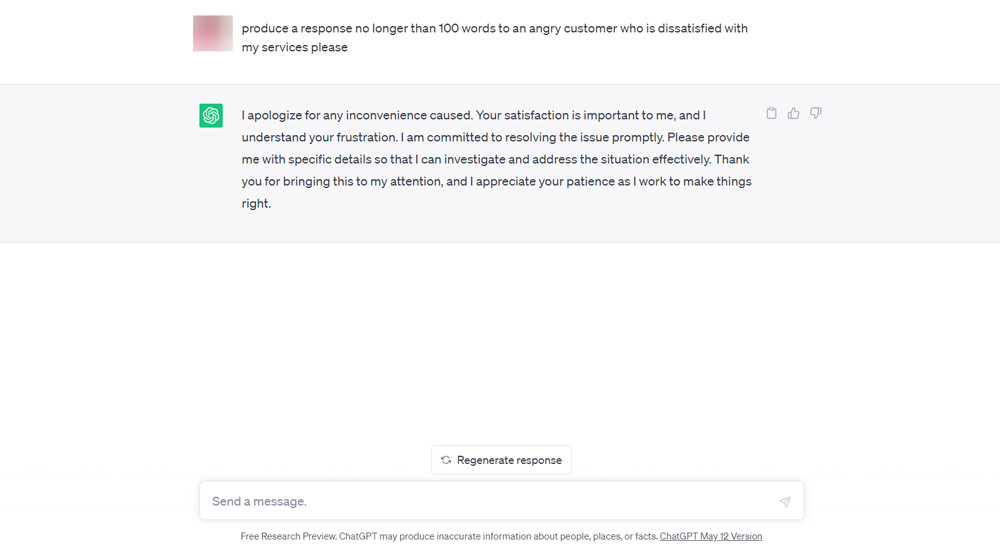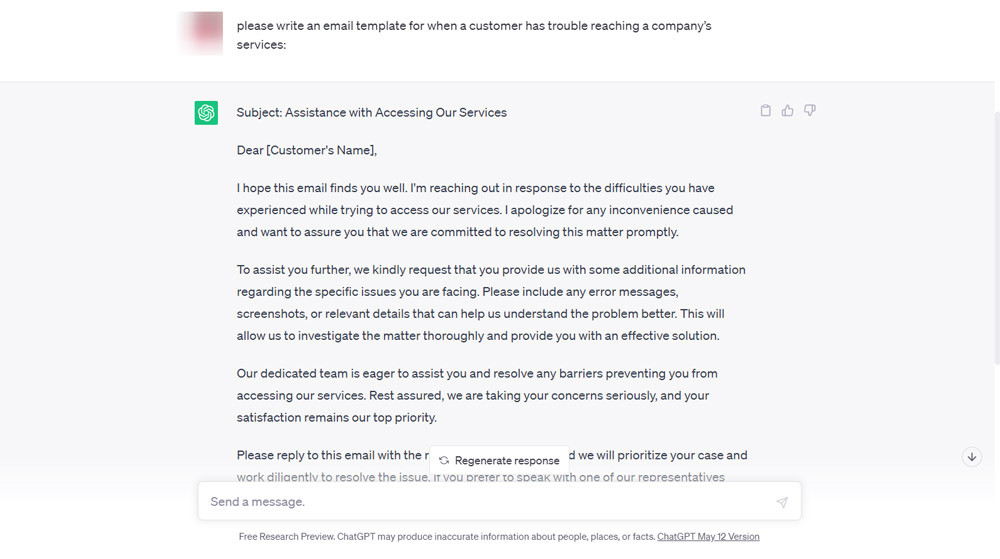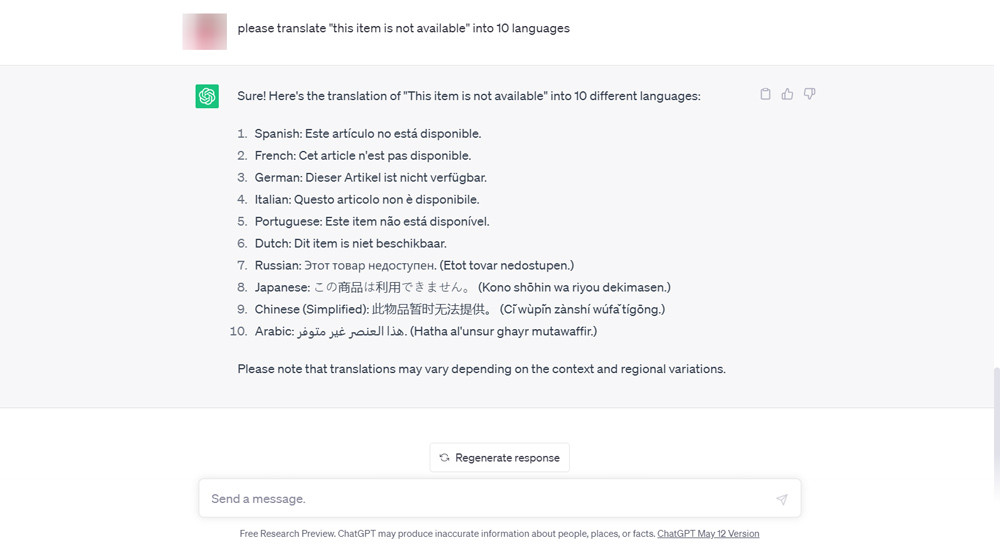ChatGPT, introduced by OpenAI in 2022, is a widely used generative AI tool primarily designed for text generation. However, its numerous valuable features make it an appealing choice for customer service chatbots.
Leveraging an AI tool can assist companies in efficiently supporting their customers while reducing the workload on their staff. This article explores how ChatGPT can enhance customer service and delves into its limitations.
What is ChatGPT?
ChatGPT, which stands for Generative Pre-Trained Transformer, is an AI tool developed by OpenAI for conversational purposes. It demonstrates the ability to comprehend and respond to a wide range of questions and prompts in a manner reminiscent of human conversation. ChatGPT is built upon OpenAI’s Large Language Model (LLM), an AI tool trained on extensive textual data for tasks like reading, translating, summarizing, and generating new sentences by predicting subsequent words.
What sets ChatGPT apart from other AI tools is its contextual understanding of language and the retention of previous conversational context. Furthermore, this chatbot has the capability to write poems and generate realistic summaries or translations of short stories, articles, and creative content. Its capacity for engaging in human-like dialogue has captured the attention of CX leaders, leading to its integration into customer service organizations. ChatGPT offers several ways to enhance customer support, which we will explore further.
8 Ways ChatGPT Can Enhance Customer Service
Large customer service organizations often receive millions of inquiries daily. By utilizing an AI tool like ChatGPT, companies can effectively respond to customers, summarize and translate their queries, and provide more efficient support. Let’s examine how ChatGPT can improve customer service in the following ways:

Responding to Customers Across Multiple Channels
Customers interact with organizations through various channels, including complaint emails, social media contact, and product review comments. With ChatGPT, customer service agents can request appropriate responses based on the specific situation. Users can customize messages in different ways, such as requesting a response no longer than 100 words. Here’s an example of a response generated by ChatGPT:

Using AI-generated emails and messages saves significant time for agents and enables them to engage with a broader range of customers daily. Employing ChatGPT to effectively respond to customers’ negative reviews can help counterbalance negative feedback and uphold the brand reputation. However, it is important for service agents to proofread the text and make necessary edits. ChatGPT needs to be trained on an organization’s policies to adhere to the company’s terms and conditions.
Another advantage of ChatGPT for inquiries is its ability to memorize previous customer interactions, allowing service agents to provide personalized support based on customer preferences and needs.
Creating Response Templates
Service agents do not necessarily have to rely on ChatGPT to respond to every inquiry. Instead, they can request the chatbot to generate response templates for different scenarios. Here’s an example of a sample email template produced by ChatGPT for addressing customers experiencing difficulties accessing a company’s services:

Replacing Simple Customer-Facing Chatbots
Many companies have implemented customer-facing chatbots to automatically respond to frequently asked questions. These chatbots are often programmed with limited predefined responses and rely on specific keywords or phrases. However, their answers may lack realism.
By substituting these chatbots with ChatGPT, customers can engage in more natural-sounding conversations even when asking repeated questions. OpenAI also offers an Application Programming Interface (API) that allows organizations to further train and customize ChatGPT to answer questions specific to their business.
Summarizing Conversations
Dealing with numerous inquiries daily can be time-consuming for customer service agents, requiring them to carefully read and understand each question to provide effective support. ChatGPT is a valuable tool for summarizing text, thanks to its extensive training on a vast dataset.
Agents can use ChatGPT to obtain concise summaries of conversations, making it easier to grasp the customers’ issues. Additionally, ChatGPT retains a summary of previous interactions, allowing agents to exclude customer data when copying text to the chatbot to prevent any potential information leaks.
Categorizing Inquiries
Organizing incoming queries can be a tedious task for customer service agents. However, ChatGPT’s ability to categorize content based on various filters can significantly streamline this process. By leveraging previous categorizations, ChatGPT can help service agents better identify the root causes of customer problems and allocate resources accordingly.
Translating Conversations
International companies serving customers worldwide often receive inquiries in different languages. ChatGPT supports 50 languages, enabling service agents to utilize this AI tool for translating customers’ questions and responses. This eliminates the requirement for an agent to be fluent in a particular language to provide support to specific customers.

However, it is worth noting that ChatGPT might struggle with texts written in spoken language or containing spelling errors, which can lead to mistranslations. In such cases, agents can rely on ChatGPT to translate the customer’s question and, if they find it challenging, refer the customer to another agent fluent in their language.
Assessing Customer Feedback through Sentiment Analysis
Sentiment analysis, a Natural Language Processing (NLP) technique, allows machines to understand and analyze the emotional tone of various content, including text, audio, video, and images. Training ChatGPT with an API makes it capable of identifying customers’ emotional states from their messages and formulating appropriate responses.
Furthermore, by analyzing received inquiries over time, ChatGPT can provide insights into customers’ overall satisfaction levels and highlight emerging trends. This empowers organizations to identify areas for improvement.
Powering Virtual Assistants
When service agents handle multiple inquiries simultaneously, a virtual assistant powered by ChatGPT can be invaluable. Companies can train ChatGPT on their databases using APIs and connect them to different departments. This virtual assistant, customized with ChatGPT’s generative AI capabilities, can help categorize customer inquiries, suggest responses, schedule appointments, and automatically summarize lengthy conversations. Additionally, it serves as a training tool for new staff by providing comprehensive instructions based on the company’s databases.
Limitations of ChatGPT
Despite its groundbreaking capabilities, ChatGPT is still under development and has certain limitations. Some of these limitations include:
- Incorrect answers: ChatGPT may occasionally provide incorrect answers, particularly for technical questions or when generating academically credible text. It prioritizes providing plausible solutions without fact-checking them, which can result in the propagation of misinformation.
- Bias in responses: The quality of content generated by ChatGPT is dependent on the dataset it was trained on. The generated answers may exhibit bias if the input data is limited or biased.
- Over-explanation: ChatGPT is trained to provide comprehensive answers, sometimes leading to verbose responses even for simple yes or no questions. It may not always discern between an inquiry about an abstract concept and a straightforward question, potentially leading to lengthy and unnecessary explanations.
- Lack of human touch: ChatGPT cannot fully replace human interaction despite its advanced capabilities. It may not fully understand a subject or accurately interpret literal or sarcastic speech. Additionally, ChatGPT lacks emotions and cannot generate genuinely empathetic responses. All the answers it provides are rearrangements of the texts it was trained on and do not stem from real-world experiences or novel insights.
In conclusion, ChatGPT is a popular generative AI tool introduced by OpenAI in 2022, primarily designed for text generation. However, it offers numerous valuable features, making it an ideal choice for customer service chatbots. By leveraging ChatGPT, companies can efficiently respond to customers across various channels, create response templates, replace simpler customer-facing chatbots, summarize conversations, categorize inquiries, translate conversations, assess customer feedback through sentiment analysis, and power virtual assistants.
Nevertheless, ChatGPT has its limitations. It may provide incorrect answers, exhibit bias based on its training data, over-explain responses, and lack the human touch necessary for genuine emotional understanding. It is important to recognize that while ChatGPT is an advanced tool, it is still far from perfect and should be used alongside human expertise to provide the best customer service experience.
Did you like this article? Do not hesitate to share it on social networks and subscribe to Tech To Geek on Google News to not miss any articles!“Because of the Google update, I, like many other blogs, lost a lot of traffic.”
Join the Newsletter
Please, subscribe to get our latest content by email.
